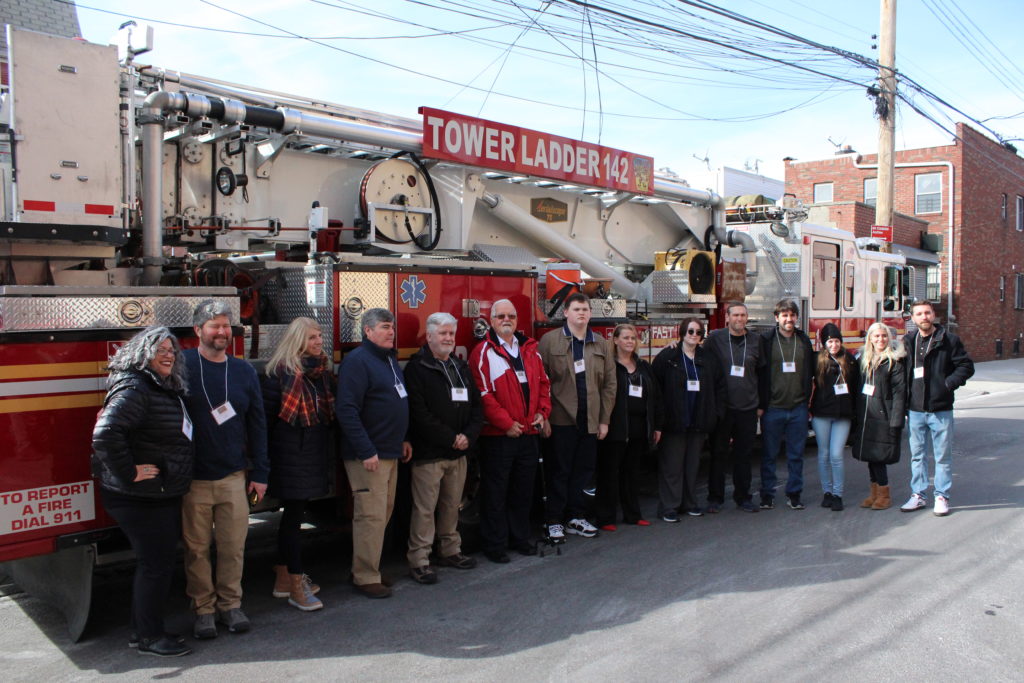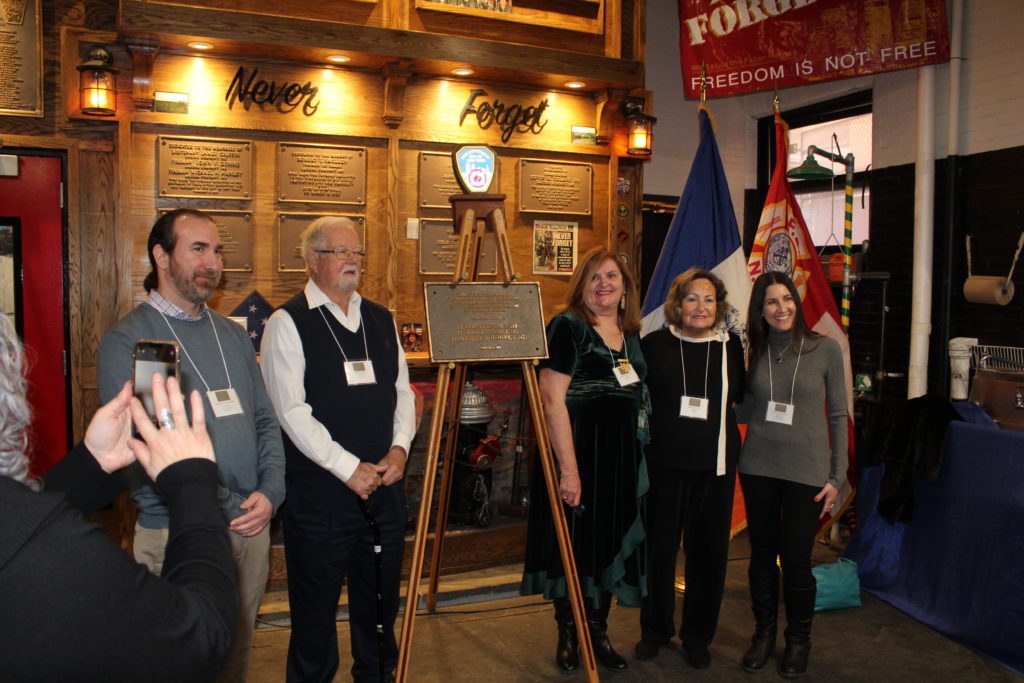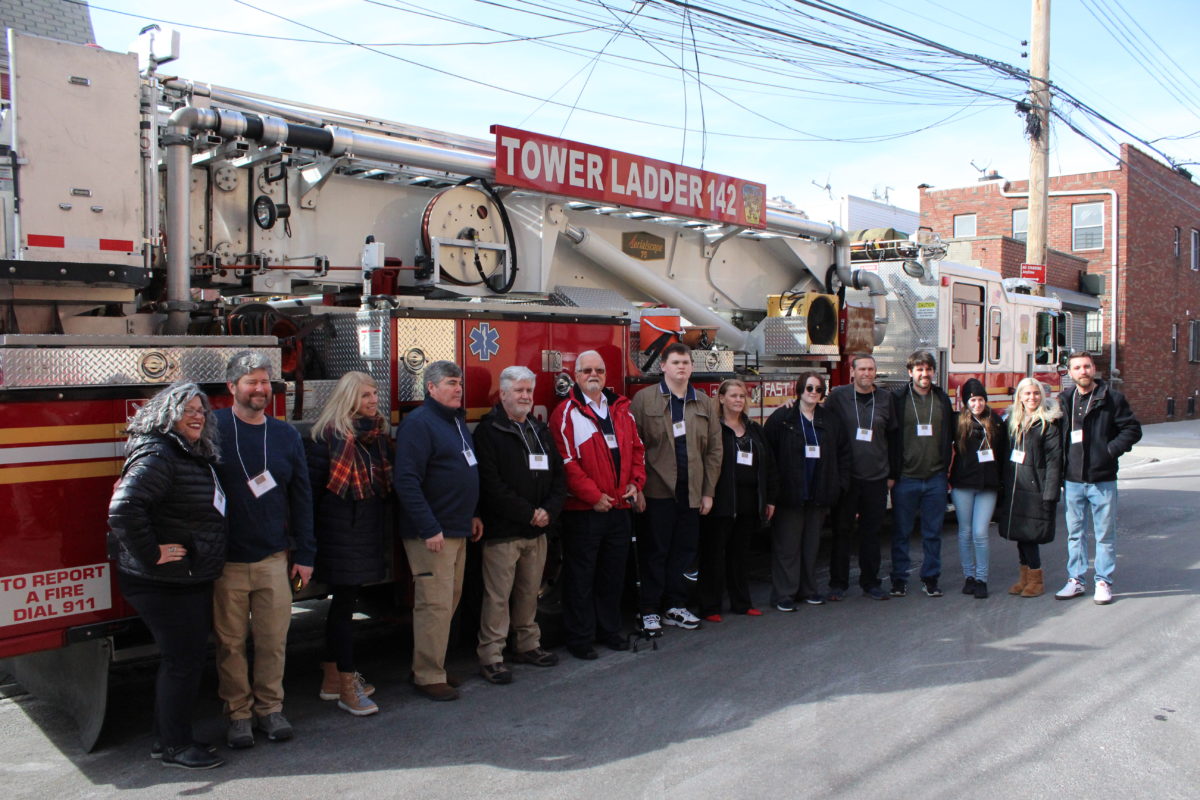By Ed Wendell

The family of Lt. James Griffin gather in front of the Ozone Park firehouse 100 years after the accident that took his life and the lives of 2 other firefighters, John Dunne and Michael Hanley.
Sometimes when you’re doing research you don’t know what you’re going to find or where it will lead. In late December, I spent a few nights going through all of the Leader-Observers from early 1923, looking for headlines to share with our members 100 years later.
One headline, about a terrible crash on February 6th, 1923, really shook me. A truck carrying three firemen from Ozone Park was struck by a Long Island Railroad express train at the intersection of Atlantic and Rockaway.
I had never heard of this tragic accident and soon temporarily abandoned the search into all things 1923 and began to focus solely on this incident and the lives of the 3 firemen, Lt. James Griffin, and Firemen John Dunne and Michael Hanley.
The details were so very sad and tragic. Just before 6 p.m. on February 6th 1923, during a heavy snowstorm, Truck 142 in Ozone Park received a call about a fire on Crescent Street.
They made their way out into the storm and when they got to the intersection of Rockaway and Atlantic, they had to wait as the LIRR workers held the local train and then raised the gate for them to pass. Then out of the snowstorm came an express train roaring from Jamaica towards Brooklyn.
The crash was horrific, dragging the wreckage hundreds of yards down Atlantic Avenue. People came running from their homes to help. Two of the firefighters, John Dunne and Michael Hanley, had been killed instantly. Lt. Griffin had hit an electrified line and though he initially survived and put up a good fight, he would pass the next day.
Together, they left 3 wives and 11 children.
And that was that. Or so I thought. I gave a Zoom presentation and shared the details of the accident. But it seemed such a shame that no one had heard about this and no one knew the names of these three heroes.
So we decided to do a special presentation on the 100th anniversary of the crash, so we would be assured that they were remembered. We found pictures of 2 of the firefighters’ tombstones online and went to the cemetery to get pictures of the third.
And when I got home, the story changed dramatically. There was an email waiting for me from a man named Brian Fitzgerald, the great-grandson of Lt. James Griffin. He had read an article in this newspaper and reached out to tell me about a ceremony they had planned for over a year. In fact, they had ordered a plaque to commemorate the sacrifice that these 3 heroes made.
This had been in the works for quite a while and Mr. Fitzgerald had done the legwork and tracked down living descendants of Firefighter Dunne, who lived nearby and would be at the ceremony.
They hadn’t been forgotten at all. 100 years later, these men were still remembered, not only by their descendants, but by the FDNY.
I should have known better. The FDNY never forgets their heroes.

And so we found ourselves at a beautiful ceremony at Engine 285 / Ladder 142 on 98th Street in Ozone Park, in the very same station house where these left on their fateful last call 100 years before.
And there were a lot of members of the Griffin family, with grandchildren, great-grandchildren and even a few great-great grandchildren. Lt. Griffin’s son served in the FDNY and his many descendants have flourished and have made him proud.
Firefighter John Dunne’s 2 great-grandchildren were there and spoke about how they knew very little about this accident until Brian Fitzgerald called and how this has impacted their lives, and how it brought them closer to the hero in their family.
Sadly, firefighter Hanley had no living descendants but he was not without family in attendance on Sunday. That is because everyone was family at this gathering. And that’s what it is like to be a member of the FDNY; being part of one big giant family.
And they proved yet again that they always honor and never forget those that went before them. In the back of E285 / L142 there is a beautiful tribute to all the brave firefighters they have lost in the line of duty over the years, and that duty is to protect and watch over us.
From that fateful evening 100 years ago, right through today, that firehouse has never been empty. It’s been on call, just like every other firehouse in New York City, every second of every day and will continue to do so forever.
God bless the souls of Lt. James Griffin, and Firemen John Dunne and Michael Hanley and every other firefighter who made the ultimate sacrifice in the line of duty; may they rest in eternal peace.





